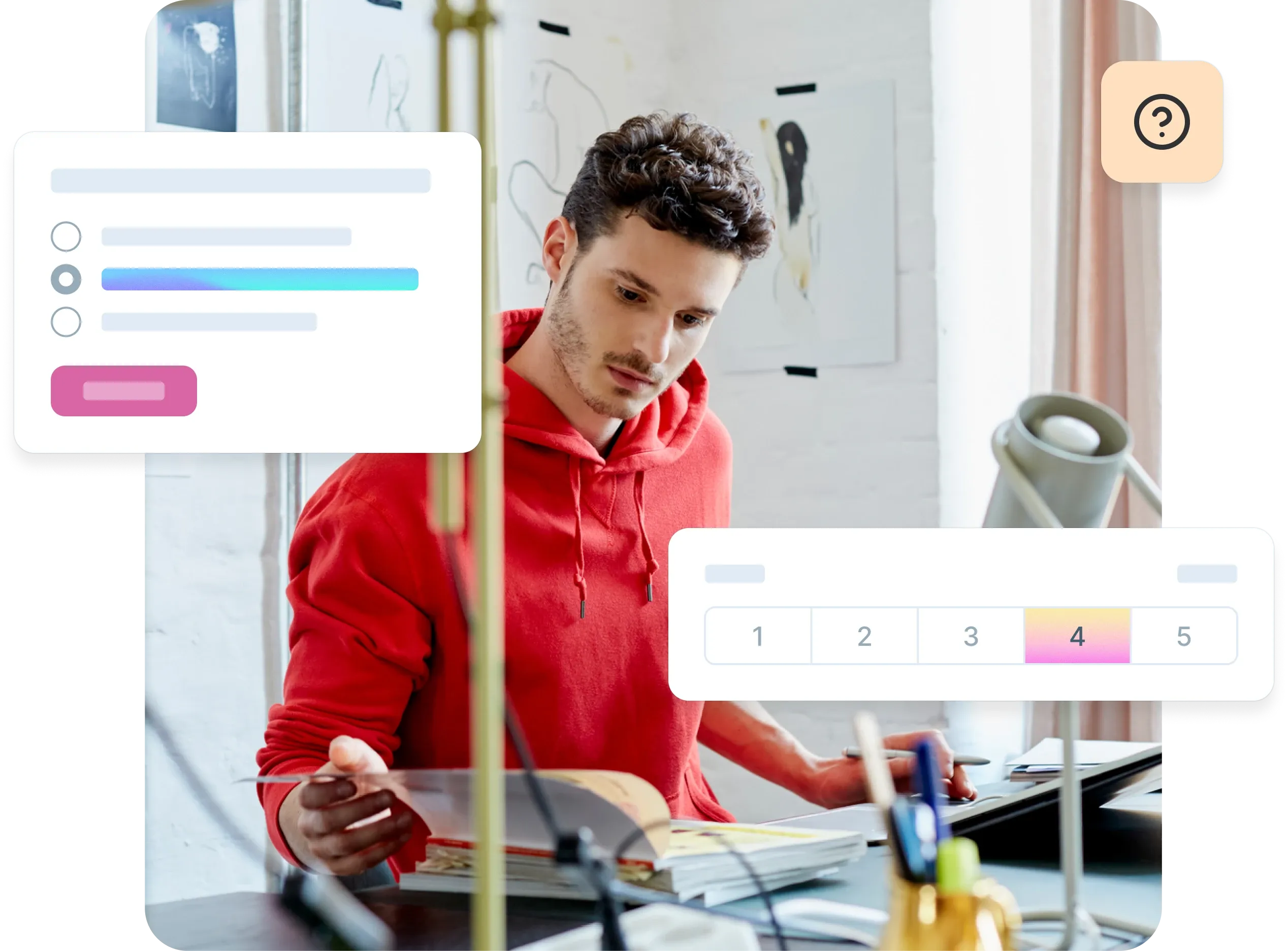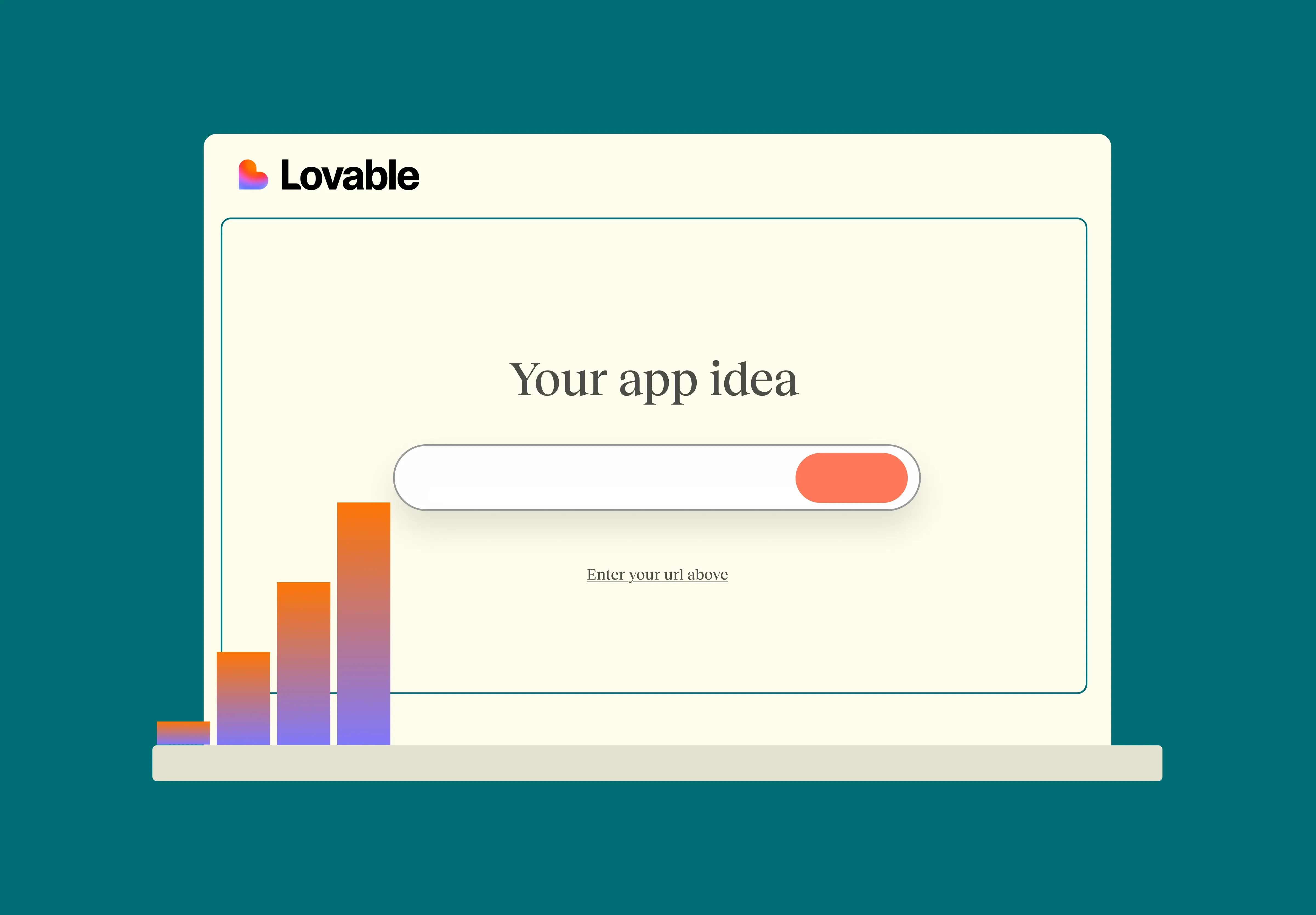18 Sep 2025
|13 min
What is a leading question?
Learn how to identify and avoid leading questions in UX research.

If your company or organization has ever tasked you with conducting research, chances are you've heard the phrase, "Make sure you don't have any leading questions!". Or something along those lines.
But what if you're not sure exactly what a leading question is and what they look like?
Leading questions are surprisingly easy to write accidentally – and they can invalidate your entire study.
A leading question guides respondents toward a particular answer through its phrasing or structure. Whether intentional or accidental, these questions introduce bias that compromises your research validity. For UX researchers, product managers, designers, and marketers conducting user interviews or surveys, understanding and avoiding leading questions is crucial for gathering authentic insights.
In this guide, we'll explore five types of leading questions with practical examples, show you how to fix them, and provide actionable strategies to keep your research unbiased.
Key takeaways
Leading questions invalidate your research by guiding participants toward specific answers, creating false insights that can mislead product decisions and user understanding.
They're surprisingly common in UX research because they often stem from researcher enthusiasm or assumptions about user experiences, making them easy to write accidentally.
Five main types exist: assumption-based questions, direct implication questions, coercive leading questions, interconnected statements, and scale-based leading questions – each creating different forms of bias.
Simple fixes work for most leading questions: remove assumptions, balance emotional language, eliminate unnecessary context, and ensure equal positive and negative response options.
Prevention is key through systematic question review, colleague feedback, and testing your surveys before launch to catch bias early in the research process.
Test questions first
Preview your tests and surveys before launching to catch leading questions that could skew results. Start testing with Lyssna free today.
Understanding leading questions in UX research
Leading questions subtly or overtly influence how participants respond by suggesting a "correct" answer. They're particularly problematic in UX research because they create a false picture of user needs and experiences.
Consider this seemingly innocent question: "How useful do you find our new dashboard feature?" This assumes the participant has used the feature and frames it as inherently useful. The participant might feel pressured to agree even if they haven't used it or found it confusing.
Expert insight: Design researcher and UX consultant Lesley Crane cautions against the oversimplification of leading questions, noting: "The last thing you want to do is skew your findings because you've led participants down a particular pathway." However, in her analysis as a discourse analyst, Crane demonstrates how cultural context affects question interpretation – showing how a question that seemed leading from a Western perspective had no influence on a participant from a different cultural background who didn't share those assumptions.

Leading questions vs loaded questions
While often confused, leading and loaded questions create different types of bias. Understanding the distinction helps you identify and eliminate both from your research.
A leading question pushes respondents toward a specific answer through its framing. For example: "Don't you think our checkout process is fast?" This clearly signals that agreeing is the expected response.
A loaded question contains an assumption that traps respondents regardless of how they answer. Consider: "Have you stopped having problems with our app?" Answering "yes" admits past problems existed; answering "no" suggests current problems persist. If the user never had problems, they can't answer accurately.
Aspect | Leading questions | Loaded questions |
|---|---|---|
What it does | Pushes toward a specific answer through framing | Contains an assumption that traps respondents |
How it works | Signals the "correct" or expected response | Forces false admissions regardless of answer |
Example | "Don't you think our checkout process is fast?" | "Have you stopped having problems with our app?" |
Problem created | Respondent feels guided to agree | Respondent can't answer accurately if assumption is false |
Why it's problematic | Compromises data quality through bias | Especially harmful - no escape from built-in assumption |
UX research example | "How much do you love our new design?" | "Why do you prefer our modern interface?" |
Key distinction | Guides toward an answer | Traps with assumptions |
Both question types compromise data quality, but loaded questions can be unfair because they force participants into false admissions. In UX research, this might look like: "Why do you prefer our modern interface?" This assumes preference exists when the user might actually find it confusing or cluttered.
The key distinction: Leading questions guide toward an answer, while loaded questions trap participants with built-in assumptions they can't escape.
Now let's examine the five specific types of leading questions you're most likely to encounter in UX research:
Questions based on assumptions
Direct implication questions
Coercive leading questions
Interconnected statements
Scale-based leading questions

Questions based on assumptions
Assumption-based questions presuppose certain facts about the participant's experience or opinions. They're the most common type of leading question in UX research because they often stem from researchers' enthusiasm about their product.
These questions typically use positive emotional language that assumes a favorable experience. For example: "How much do you enjoy using our collaboration tools?" assumes enjoyment exists. The participant might not enjoy them at all but feels pressured to provide a positive response due to social desirability bias.
Interestingly, cultural context plays a role here. Crane, writing about her experience as both a UX researcher and discourse analyst, observed: "What I was doing was displaying my understanding of western, and particularly British, social norms and cultural norms." Her research found that assumptions about user behavior that seem universal might actually be culturally specific, making assumption-based questions even more problematic in diverse user research.
Here are three common examples of questions based on assumptions (with fixes):
❌ Problematic question | ✅ Better question | Why it’s better |
|---|---|---|
How satisfied are you with our responsive customer support? | How would you describe your experience with our customer support? | Doesn't assume satisfaction or responsiveness |
Which of our innovative features do you use most? | Which features, if any, do you use regularly? | Doesn't assume usage or innovation |
How has our product improved your workflow? | Has our product affected your workflow? If so, how? | Allows for no impact or negative impact |
To avoid assumptions systematically, consider using survey logic that branches based on initial responses. Instead of assuming someone uses a feature, first ask: "Have you used the reporting feature?" Then, only if they answer "yes," follow up with questions about their experience. This approach, available through tools like Lyssna's survey logic, ensures you're only asking relevant questions based on actual user behavior.
Quick tip: Before writing any question about user experience, ask yourself: "Am I assuming they've done something, felt something, or believe something?" If yes, rewrite to allow for all possibilities.

Direct implication questions
Direct implication questions create a transactional pressure by suggesting that one answer leads to a reward or consequence. They frame the question as an exchange, making participants feel their response determines future opportunities or benefits.
These questions often appear in feature adoption research and loyalty program studies. They're particularly problematic because they conflate genuine interest with desire for rewards, making it impossible to measure true user sentiment.
A fundamental principle of good UX research is allowing users to express themselves naturally without artificial constraints or pressures. When we create situations where participants feel their answers determine their access to features, opportunities, or rewards, we're no longer measuring genuine user sentiment – we're measuring their strategic responses to perceived incentives.
Consider these examples of direct implication questions with corrections:
❌ Problematic question | ✅ Better question | Why it’s better |
|---|---|---|
If you enjoyed our beta program, would you like early access to future features? | Would you like to participate in future beta programs? (Then separately ask about their beta experience) | Removes the conditional reward; separates interest from past experience |
Since you're one of our power users, would you be willing to provide detailed feedback? | We're looking for detailed feedback from various users. Would you be interested in participating? | Eliminates special status pressure; treats all users equally |
If you found value in the free trial, shall we discuss pricing options? | How would you describe your experience with the free trial? (Follow up based on their response) | Removes sales pressure; allows honest feedback without consequence |
The key to fixing direct implication questions is removing the conditional framing. Don't link participation, feedback, or future actions to positive experiences. Let participants express their genuine opinions without feeling that honesty might cost them opportunities.

Coercive leading questions
Coercive questions represent the most aggressive form of leading question. They use forceful language to push respondents toward agreement, often ending with tag questions like "right?" or "don't you think?" These questions exploit social pressure and politeness norms.
Warning signs of coercive questions:
They end with a question seeking confirmation
They use absolute language ("obviously," "clearly," "definitely")
They would sound aggressive if spoken aloud
They make disagreement feel impolite
The psychological pressure these questions create is significant. Participants often agree simply to avoid confrontation or appear difficult. This is especially true in live interviews where the pressure to maintain social harmony is strongest.
Common phrases that signal coercion include:
"...don't you agree?" - Forces agreement through social pressure
"...right?" - Assumes consensus; hard to disagree
"...wouldn't you say?" - Suggests the "correct" answer
"...correct?" - Frames disagreement as being wrong
"Obviously..." - Makes disagreement seem ignorant
"Surely you..." - Implies any other view is unreasonable
Here are examples of coercive leading questions and how to make them better:
❌ Problematic question | ✅ Better question | Why it's better |
|---|---|---|
Our new design is much cleaner than before, don't you agree? | How would you compare our new design to the previous version? | Removes assumption and pressure; allows any comparison |
You'll definitely recommend our service to colleagues, won't you? | How likely are you to recommend our service to colleagues? (Use 0-10 scale) | Eliminates certainty assumption; provides measurable scale |
This update obviously makes the workflow faster, correct? | How has this update affected your workflow speed? | Removes "obvious" assumption; allows for any impact |
The solution is using balanced Likert scales that provide equal positive and negative options. For example, a 5-point satisfaction scale should include: Very Dissatisfied, Dissatisfied, Neutral, Satisfied, Very Satisfied. This gives participants permission to express negative opinions without feeling confrontational.

Interconnected statements
Interconnected statement questions use context to manipulate responses. They begin with a statement about what others do or believe, then ask about the participant's behavior or opinions. This creates social proof pressure that influences responses.
These questions are especially common in employee feedback and user behavior research. They suggest that certain behaviors or opinions are normal or expected, making participants feel like outliers if they disagree.
As Crane observes: "Researchers should always include themselves as active participants in the action when coding and analysing our data. If we do not, we risk psychological and behavioural transference from ourselves to participants which influences the interpretation and analysis of participant data without realising it."
This insight is particularly relevant for interconnected statements, where researchers unconsciously project their understanding of "normal" user behavior onto participants.
Here are examples of interconnected statements and how to make them better:
❌ Problematic question | ✅ Better question | Why it’s better |
|---|---|---|
Most of our engaged users check analytics daily. How often do you check yours? | How often, if at all, do you check your analytics? | Removes social pressure and the engaged user comparison; allows honest reporting |
Our highest-performing teams use the collaboration features extensively. Which collaboration features does your team use? | Does your team use any of our collaboration features? If so, which ones? | Eliminates performance judgment; doesn't assume usage |
Many customers tell us they love the automated reporting. What aspects of automated reporting work best for you? | Do you use automated reporting? If yes, what has your experience been? | Doesn't assume usage or positive feelings; allows any response |
To fix interconnected statements, separate context from questions entirely. If you must provide context, present it neutrally after collecting unbiased responses. For instance, gather feedback first, then share comparative data if relevant.

Scale-based leading questions
Scale-based leading questions create mathematical bias through unbalanced response options. Unlike other leading questions that use language to influence, these use the structure of answer choices to skew results toward positive or negative responses.
The bias occurs when scales offer more options on one side of neutral than the other. If participants have three ways to express satisfaction but only two for dissatisfaction, probability alone increases positive responses.
Here are examples of scale-based leading questions and how to make them better:
Type | ❌ Problematic | Why it’s wrong | ✅ Better |
|---|---|---|---|
Satisfaction scale | 1- Extremely satisfied 2- Very satisfied 3- Satisfied 4- Somewhat satisfied 5- Neutral 6- Dissatisfied | 4 positive options vs 1 negative Random responses skew positive | 1. Very satisfied 2. Satisfied 3. Neutral 4. Dissatisfied 5. Very dissatisfied |
Frequency scale | Always (100% of the time) Usually (75% of the time) Sometimes (50% of the time) Occasionally (25% of the time) Rarely (less than 10% of the time) | Inconsistent intervals 15% gap at bottom vs 25% elsewhere | Alway Often Sometimes Rarely Never |
Rules for proper scale construction
Equal number of positive and negative options
Consistent intervals between points
Clear, distinct labels for each point
Neutral midpoint for odd-numbered scales
Parallel language structure across options
Best practices checklist
Count your positive versus negative options
Ensure linguistic balance (if one says "very satisfied," include "very dissatisfied")
Test whether the scale makes sense in reverse
Avoid mixing frequencies with intensities
Keep scales consistent throughout your survey

Best practices for avoiding leading questions
Creating unbiased questions requires systematic review and deliberate practice. These strategies will help you identify and eliminate leading questions before they compromise your research.
1. Remove personal opinions and preferences
Your questions should be neutral vessels for collecting data, not vehicles for your hypotheses. Instead of "How innovative do you find our solution?" ask "How would you describe our solution?"
2. Balance emotional language
If you must use evaluative terms, provide equal positive and negative options. "How easy or difficult was it to complete the task?" is better than "How easy was it to complete the task?"
3. Eliminate unnecessary context
Every piece of information you provide can influence responses. Strip questions down to their essential elements. Context can come after you've collected unbiased initial responses.
4. Test questions systematically
Use preview mode to experience your survey as participants will. Read questions aloud – coercive language often becomes obvious when spoken. Have colleagues review your questions, especially those unfamiliar with your project who can spot assumptions you might miss.
As Crane notes, having external review is crucial because we often can't see our own assumptions and biases that might be influencing our question design.
A question review checklist
Does this assume prior knowledge or experience?
Can someone answer negatively without feeling rude?
Are positive and negative responses equally easy to give?
Would this question make sense to someone who's never used our product?
Am I fishing for a specific answer?
Template for neutral questions
Experience questions: "How would you describe your experience with [feature]?"
Frequency questions: "How often, if at all, do you [behavior]?"
Comparison questions: "How does [A] compare to [B] for your needs?"
Opinion questions: "What are your thoughts on [topic]?"

Start testing now
Ready to improve your research? Get reliable user feedback and unbiased insights with Lyssna's research tools – start free today.
How Lyssna helps you avoid leading questions
Leading questions are research validity killers, but they're entirely preventable. By understanding the five types – assumption-based, direct implication, coercive, interconnected statements, and scale-based – you can identify and fix them before they compromise your data.
Creating unbiased questions becomes easier with the right tools. Lyssna provides several features that help you gather authentic feedback without leading participants.
Our research panel gives you access to unbiased participants, reducing the social desirability bias that creates false positives. When you're testing with your own users, they might feel obligated to be positive. Panel participants provide honest, unfiltered feedback.
Survey logic lets you branch questions based on responses, eliminating assumption-based questions. First confirm whether someone has used a feature, then ask about their experience only if relevant.
The preview and test mode allows you to experience your survey as participants will, helping you spot leading questions before launch. Quick iteration means you can refine questions based on initial feedback without losing momentum.
Easily collaborate with your team in real-time in the test creation phase by leaving comments in the test builder.
Ready to gather unbiased insights? Start creating better research questions with Lyssna's free plan.
FAQs

Alexander Boswell
Technical writer
Alexander Boswell is the Founder/Director of SaaSOCIATE, a B2B SaaS, MarTech and eCommerce Content Marketing Service and a Business PhD candidate. When he’s not writing, he’s playing baseball and D&D.
You may also like these articles


Try for free today
Join over 320,000+ marketers, designers, researchers, and product leaders who use Lyssna to make data-driven decisions.
No credit card required





